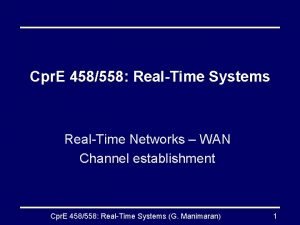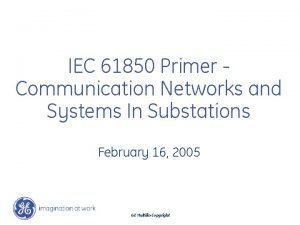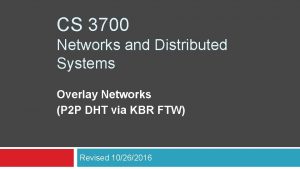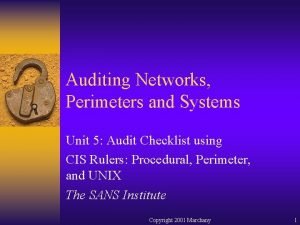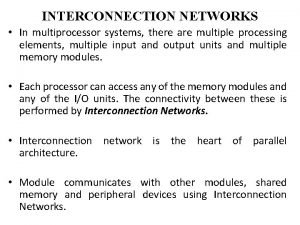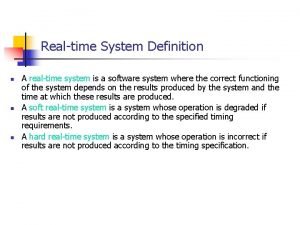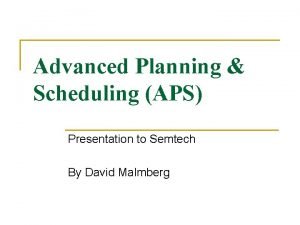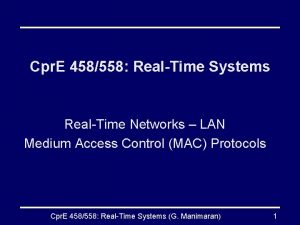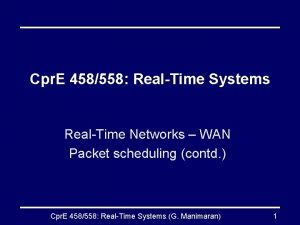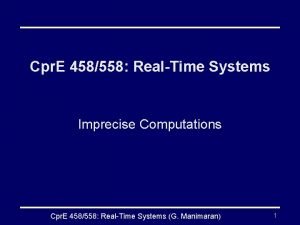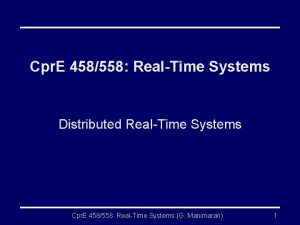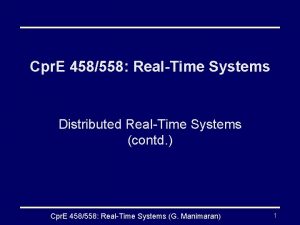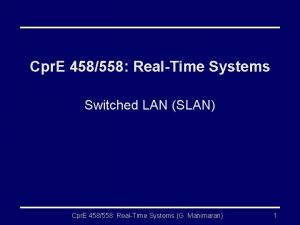Cpr E 458558 RealTime Systems RealTime Networks LAN









- Slides: 9

Cpr. E 458/558: Real-Time Systems Real-Time Networks – LAN Basic concepts Cpr. E 458/558: Real-Time Systems (G. Manimaran) 1

Channel model - Shared medium (Bus, Ring) Node 1 Node 2 Node 3 …………. Node n Shared Bus • What is the difference between Task Scheduling & Medium Access Control (MAC) in LAN? • What is the difference between Packet Scheduling in WAN and MAC in LAN? Cpr. E 458/558: Real-Time Systems (G. Manimaran) 2

Messages (Packets) • Periodic messages (streams) • Aperiodic messages • Dynamically arriving periodic messages Cpr. E 458/558: Real-Time Systems (G. Manimaran) 3

Bus scheduling vs. Processor scheduling • Task Preemption – Tasks can be preempted, but packets cannot be • Granularity of priority levels – Task scheduling: potentially an arbitrary number of priority levels – Packet scheduling: fixed number of priority levels priority inversion • Buffering problems – Unique to packet scheduling – Shortening packet deadline (changing the priority) based on buffer availability Cpr. E 458/558: Real-Time Systems (G. Manimaran) 4

Real-Time MAC protocols • Access arbitration process – Decides when a particular node should transmit – This impacts the throughput, channel access delay, deadline, and fairness characteristics • Transmission control process – Decides for how long a particular node continue to transmit – Static: the channel holding time is predetermined – Dynamic: holding time is determined at run-time – This impacts the throughput, deadline, and fairness characteristics Cpr. E 458/558: Real-Time Systems (G. Manimaran) 5

RT-MAC design issues • Predictability • Timing correctness • Protocol overhead • Channel utilization • Fairness • Stability during transient overloads Cpr. E 458/558: Real-Time Systems (G. Manimaran) 6

End-to-end message delay • Sender: – Application layer: processing and queuing delays – MAC layer: queuing delay • Channel access time • Transmission delay • Propagation delay • Receiver: – MAC layer: queuing delay – Application layer: queuing and processing delays Cpr. E 458/558: Real-Time Systems (G. Manimaran) 7

Real-Time guarantees • Static guarantees – Periodic messages (streams) • Dynamic guarantees – Aperiodic messages, Aperiodic streams • Hybrid of static and dynamic guarantees • Best effort Cpr. E 458/558: Real-Time Systems (G. Manimaran) 8

Inadequacies of traditional LAN protocols • 802. 3 (CSMA/CD) • 802. 4 (token bus) • 802. 5 (token ring) • 802. 11 (Wi-Fi) Cpr. E 458/558: Real-Time Systems (G. Manimaran) 9
 Realtime networks
Realtime networks Virtual circuit and datagram networks
Virtual circuit and datagram networks Basestore iptv
Basestore iptv Iec 61850 communication networks and systems in substations
Iec 61850 communication networks and systems in substations Overlay networks in distributed systems
Overlay networks in distributed systems Computer networks vs distributed systems
Computer networks vs distributed systems Auditing networks perimeters and systems
Auditing networks perimeters and systems Interconnection networks in multiprocessor systems
Interconnection networks in multiprocessor systems Real time software definition
Real time software definition Realtime aps software
Realtime aps software
